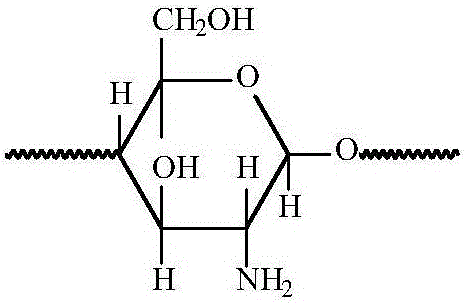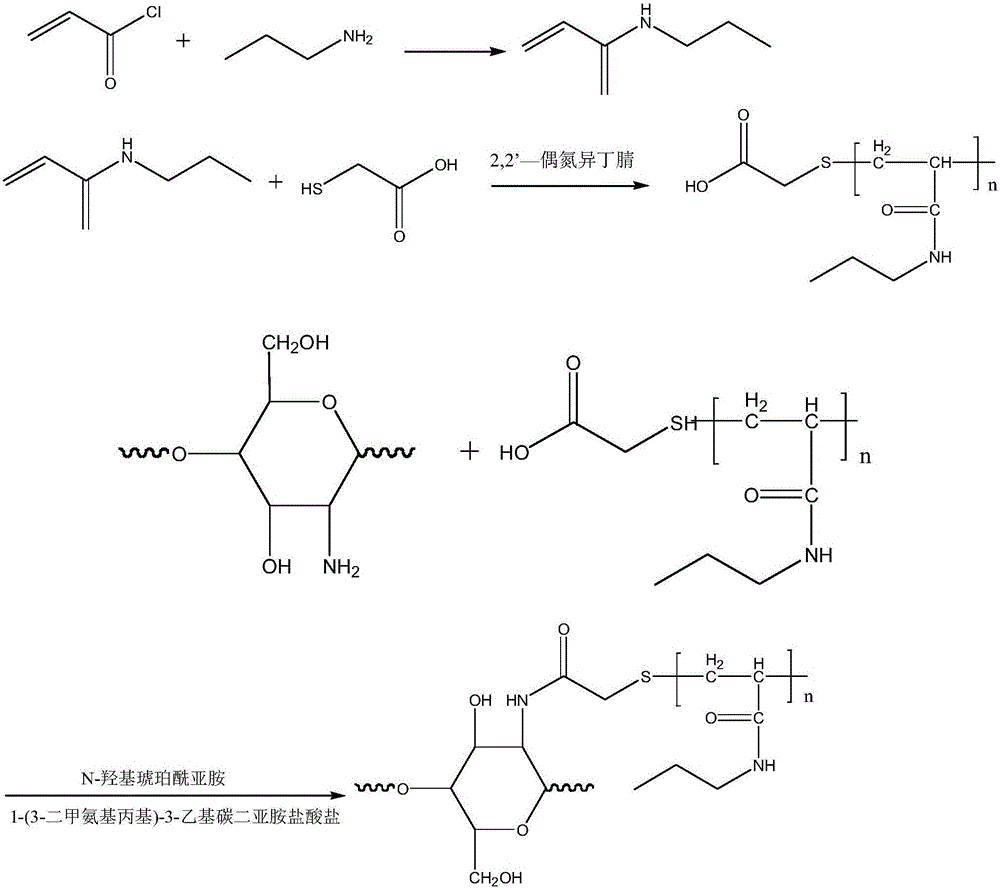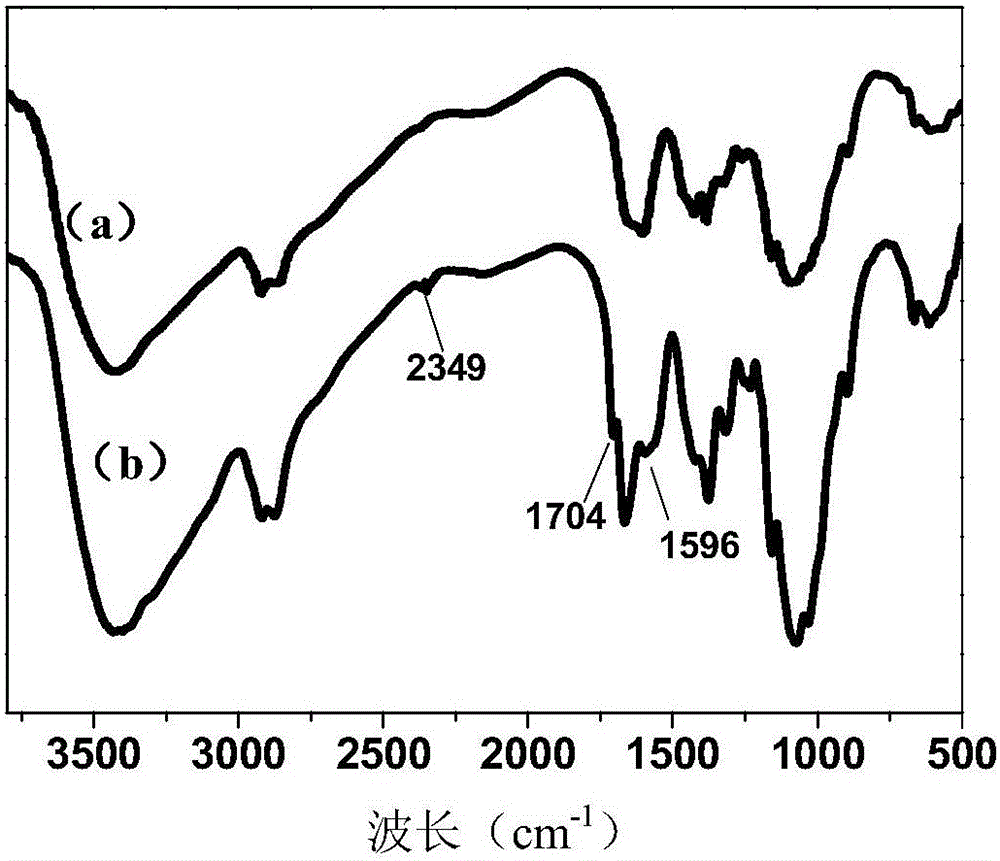Temperature sensitive chitosan flocculant and preparing method and application thereof
A chitosan and sensitive technology, which is applied in the field of temperature-sensitive chitosan flocculant and its preparation, can solve the problems of limited application scope, no temperature sensitivity of temperature switch, and no secondary pollution risk. , Excellent flocculation ability, wide range of effects
- Summary
- Abstract
- Description
- Claims
- Application Information
AI Technical Summary
Problems solved by technology
Method used
Image
Examples
Embodiment 1
[0054] Acryloyl chloride, n-propylamine and triethylamine were respectively dissolved in toluene (wherein the molar ratio of acryloyl chloride, n-propylamine and triethylamine was 1:1.1:1.2) for use. At 4°C, the acryloyl chloride solution was slowly added dropwise to a mixed solution of n-propylamine and triethylamine (solvent is toluene) with stirring for 1 hour, and then the mixture was stirred and reacted at 25°C for 24 hours. The reaction mixture was filtered to remove the resulting precipitate, resulting in a monomer (in toluene) solution. Thioglycolic acid was dissolved in toluene (the molar ratio of acryloyl chloride and thioglycolic acid was 20:1), placed in a round-bottomed flask, and stirred to dissolve completely. The temperature was raised to 60 °C, and nitrogen was introduced for 30 min to remove the oxygen in the solution. Add 2,2'-azoisobutyronitrile (AIBN for short, the solvent is toluene, the molar mass ratio of 2,2'-azoisobutyronitrile to acryloyl chloride i...
Embodiment 2
[0057] Acryloyl chloride, n-propylamine and triethylamine were respectively dissolved in toluene (wherein the molar ratio of acryloyl chloride, n-propylamine and triethylamine was 1:1.2:2) for use. The acryloyl chloride solution was slowly added dropwise to a mixed solution of n-propylamine and triethylamine (solvent is toluene) at 4°C for 1 hour while stirring, and then the mixture was stirred at 30°C for 12 hours. The reaction mixture was filtered to remove the resulting precipitate, resulting in a monomer (in toluene) solution. Thioglycolic acid was dissolved in toluene (the molar ratio of acryloyl chloride and thioglycolic acid was 18:1), placed in a round-bottomed flask, and stirred to dissolve completely. The temperature was raised to 70°C, and nitrogen gas was introduced for 30min to remove the oxygen in the solution. Add 2,2'-azoisobutyronitrile (solvent is toluene, the molar mass ratio of 2,2'-azoisobutyronitrile to acryloyl chloride is 1:3, solvent and 2,2'-azoisobuty...
Embodiment 3
[0060] Acryloyl chloride, n-propylamine and triethylamine were respectively dissolved in toluene (wherein the molar ratio of acryloyl chloride, n-propylamine and triethylamine was 1:1.3:1.4) for use. The acryloyl chloride solution was slowly added dropwise to a mixed solution of n-propylamine and triethylamine (solvent is toluene) at 4°C for 1 hour while stirring, and then the mixture was stirred at 23°C for 15 hours. The reaction mixture was filtered to remove the resulting precipitate, resulting in a monomer (in toluene) solution. Thioglycolic acid was dissolved in toluene (the molar ratio of acryloyl chloride to thioglycolic acid was 16:1), placed in a round-bottomed flask, and stirred to dissolve completely. The temperature was raised to 80°C, and nitrogen gas was introduced for 30min to remove the oxygen in the solution. Add 2,2'-azoisobutyronitrile (solvent is toluene, the molar mass ratio of 2,2'-azoisobutyronitrile to acryloyl chloride is 1:4, solvent and 2,2'-azoisob...
PUM
 Login to View More
Login to View More Abstract
Description
Claims
Application Information
 Login to View More
Login to View More - R&D
- Intellectual Property
- Life Sciences
- Materials
- Tech Scout
- Unparalleled Data Quality
- Higher Quality Content
- 60% Fewer Hallucinations
Browse by: Latest US Patents, China's latest patents, Technical Efficacy Thesaurus, Application Domain, Technology Topic, Popular Technical Reports.
© 2025 PatSnap. All rights reserved.Legal|Privacy policy|Modern Slavery Act Transparency Statement|Sitemap|About US| Contact US: help@patsnap.com



